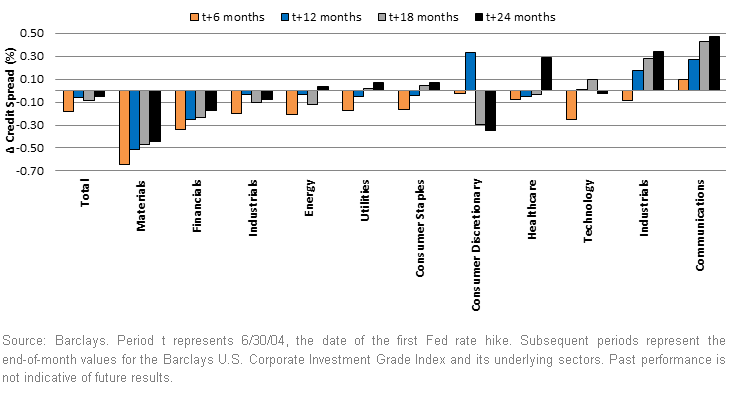The Impact of Fed Tightening on U.S. Investment Grade Credit


 Sector Impact over Time
With the exception of the Technology and Consumer Discretionary sectors, the trend in credit from 2004 shows that spreads initially tighten, then gradually widen back to around unchanged at the peak of the interest rate cycle. Additionally, Materials, Financials and Industrials were previously the strongest performers. For Financials, rising rates often translate into wider net interest margins , ultimately helping banks drive earnings. For the Materials sector, commodity prices generally rose over this period on the back of strong growth from emerging markets. Overall, credit across sectors tended to correlate over time, albeit with varying degrees of magnitude.
Finally, while the trend in credit spreads is important from a positioning perspective, investors should also be aware of the all-in level of spreads. A primary reason the Communications sector appears to underperform over this period is that it had initially been trading at some of the lowest spread levels (78 bps over Treasuries) of any sector at that time. Today, credit spreads are materially wider than 2004 levels across all sectors (+55 bps). In fact, spreads currently average 155 bps over Treasuries across all sectors, ranging from a low of 121 bps for capital goods to a high of 268 bps for basic materials.
Pace of Hikes
Now that the Fed has announced its first hike of this cycle, the debate among market participants will ultimately begin to shift to the pace of rate hikes and the terminal level of interest rates for this cycle. During the 2004 tightening cycle, the Fed hiked rates at one of the most consistent paces in history. Over the first six months, the Fed hiked rates five times. Over the next 18 months, it increased rates by 100 basis points every six months. Ultimately, the target of the Federal Funds Rate rose to a high of 5.25%. Today, the Fed is forecasting four hikes for 2016 and a peak in the Fed Funds Rate of 3.5% in the long run. With a slower pace of tightening and a lower terminal rate, we believe that the net impact on credit has the potential be more subdued than in previous periods.
While the impact of changes in Fed policy will continue to be hotly debated in the coming months, we don’t currently view this initial shift as particularly troubling for U.S. investment-grade credit. For borrowers, this incremental shift in policy is hardly a surprise. For lenders, credit spreads have already widened materially in advance of this move. In our view, investment-grade credit could continue to offer value over at least the next six months as investors and markets digest the shift in policy.
Sector Impact over Time
With the exception of the Technology and Consumer Discretionary sectors, the trend in credit from 2004 shows that spreads initially tighten, then gradually widen back to around unchanged at the peak of the interest rate cycle. Additionally, Materials, Financials and Industrials were previously the strongest performers. For Financials, rising rates often translate into wider net interest margins , ultimately helping banks drive earnings. For the Materials sector, commodity prices generally rose over this period on the back of strong growth from emerging markets. Overall, credit across sectors tended to correlate over time, albeit with varying degrees of magnitude.
Finally, while the trend in credit spreads is important from a positioning perspective, investors should also be aware of the all-in level of spreads. A primary reason the Communications sector appears to underperform over this period is that it had initially been trading at some of the lowest spread levels (78 bps over Treasuries) of any sector at that time. Today, credit spreads are materially wider than 2004 levels across all sectors (+55 bps). In fact, spreads currently average 155 bps over Treasuries across all sectors, ranging from a low of 121 bps for capital goods to a high of 268 bps for basic materials.
Pace of Hikes
Now that the Fed has announced its first hike of this cycle, the debate among market participants will ultimately begin to shift to the pace of rate hikes and the terminal level of interest rates for this cycle. During the 2004 tightening cycle, the Fed hiked rates at one of the most consistent paces in history. Over the first six months, the Fed hiked rates five times. Over the next 18 months, it increased rates by 100 basis points every six months. Ultimately, the target of the Federal Funds Rate rose to a high of 5.25%. Today, the Fed is forecasting four hikes for 2016 and a peak in the Fed Funds Rate of 3.5% in the long run. With a slower pace of tightening and a lower terminal rate, we believe that the net impact on credit has the potential be more subdued than in previous periods.
While the impact of changes in Fed policy will continue to be hotly debated in the coming months, we don’t currently view this initial shift as particularly troubling for U.S. investment-grade credit. For borrowers, this incremental shift in policy is hardly a surprise. For lenders, credit spreads have already widened materially in advance of this move. In our view, investment-grade credit could continue to offer value over at least the next six months as investors and markets digest the shift in policy.
Important Risks Related to this Article
Fixed income investments are subject to interest rate risk; their value will normally decline as interest rates rise. In addition, when interest rates fall, income may decline. Fixed income investments are also subject to credit risk, the risk that the issuer of a bond will fail to pay interest and principal in a timely manner or that negative perceptions of the issuer’s ability to make such payments will cause the price of that bond to decline.


